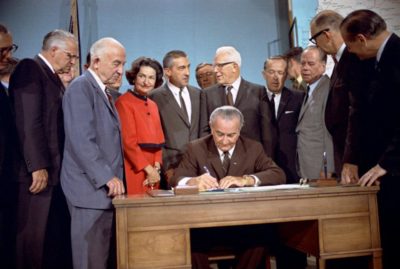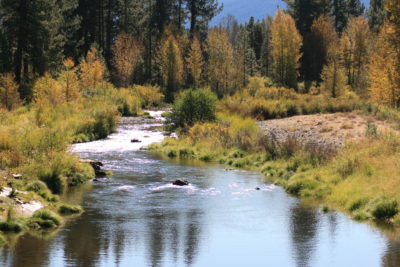The Wild & Scenic Rivers Act Turns 50
Celebrating a Half Century of Protecting America’s Rivers–& Hoping for More River Conservation Ahead
1968 was an especially tumultuous year in modern American history. The nation endured the assassinations of both Martin Luther King, Jr. and Robert F. Kennedy; then-President Lyndon Johnson announced he would not seek reelection due to growing public dissatisfaction with the government’s conduct of the Vietnam War; and protests and riots consumed Chicago, Detroit, Washington, D.C. and many other American cities.
So it was in stark contrast and a most welcome development when in 1968 Congress passed, and (in October of that year) a lame duck President Johnson signed into law the Wild and Scenic Rivers Act (Public Law 90-542). The Act represented a major political and conservation achievement 50 years ago. It remains an important cornerstone of America’s conservation efforts a half century later.

Congress’ objective in enacting the WSRA is set forth in the opening passages of the statute:
It is hereby declared to be the policy of the United States that certain selected rivers of the Nation which, with their immediate environments, possess outstandingly remarkable scenic, recreational, geologic, fish and wildlife, historic, cultural or other similar values, shall be preserved in free-flowing condition, and that they and their immediate environments shall be protected for the benefit and enjoyment of present and future generations. The Congress declares that the established national policy of dams and other construction at appropriate sections of the rivers of the United States needs to be complemented by a policy that would preserve other selected rivers or sections thereof in their free-flowing condition to protect the water quality of such rivers and to fulfill other vital national conservation purposes.
The WSRA establishes a National Wild and Scenic Rivers System. Rivers can be designated both by Congress and, in certain cases, by the Secretary of the Interior. (The 1968 statute itself designated eight rivers as inaugural components of the system: the Feather, Rio Grande, Rogue, St. Croix, Salmon, Clearwater and Wolf Rivers.) Fifty years later, the WSRA protects 12,754 linear miles of 209 rivers located in 40 states and Puerto Rico. In California alone, stretches of 22 rivers–in addition to the Feather–are designated for protection under the WSRA.
Responsibility for administering the WSRA is shared among several federal agencies–the U.S. Forest Service, the National Park Service, the Bureau of Land Management and the U.S. Fish and Wildlife Service. States can propose that additional rivers be added to the National Wild and Scenic Rivers System by application of a state’s governor and approval by the Secretary of the Interior; those rivers are managed by the nominating states and are subject to the same protections as federally-administered rivers. Some states have gone further and, like California, enacted their own state wild and scenic rivers acts to designate and protect additional rivers and streams under state law.

Under the WSRA, rivers are classified as wild, scenic or recreational. Wild River Areas are those that are free of dams and generally inaccessible except by trails, with watersheds or shorelines essentially primitive and waters unpolluted. Scenic River Areas are those free of dams and with shorelines and watersheds still largely primitive and undeveloped, but accessible by roads. Recreational River Areas are readily accessible by road or rail, that may have some development along their shoreline, and that may have undergone past dams and diversions. Regardless of their classification, each river in the National Wild and Scenic Rivers System is administered with the goal of protecting and enhancing the values that caused it to be designated in the first place.
The WSRA, authored by Senator Frank Church (D-Idaho), was a legislative response to the fact that in 1968, many if not most of America’s rivers were already dammed for hydroelectric and flood control projects. (By comparison to rivers designated under the WSRA, more than 75,000 large dams in the U.S. have modified over 600,000 miles of American rivers.)
The WSRA is a testament to the fact that rivers should not be viewed as garbage dumps, industrial sewers and sources of electricity. Rather, preserved in their natural state, rivers provide critical ecosystem services, scenic splendor and valuable recreational opportunities.
Of course, the WSRA is but one of a suite of important federal statutes intended to preserve our nation’s precious natural resources. But on this, the 50th anniversary of the WSRA, we should pause to give thanks to national leaders who a half century ago had the vision to recognize the inherent value of our river systems and provide the regulatory tools to preserve them. I have little confidence that the current Congress and presidential administration will see fit to protect more American rivers under the WSRA. But as we celebrate the enactment of the WSRA 50 years ago, let’s hope and advocate that future national leaders continue to bring additional rivers and streams into the National Wild and Scenic Rivers System.







Reader Comments